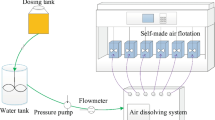Abstract
A mathematical model for removing low-concentration suspension from raw water by dissolved air flotation method for drinking water is described. Methods The mathematical model is based on the known equations and dependencies of mass transfers. It takes into account the effect of the delayed bubbles on their rise velocity, as well as technological and design parameters. Results The numerical value of the flotation process constant has been obtained for waters with low concentrations of suspended solids. Scientific novelty The mathematical model which, for the first time, works with regard to the effect of bubbles delayed on rise velocity, as well as technological and design parameters such as water rise velocity, suspended solid concentration and particle size of containments, size of air bubbles and their concentration, is demonstrated. Practical significance The developed mathematical model enables in the future to study the design parameters of flotation tank and find the optimal dimensions with a high degree of clarification.
Access this chapter
Tax calculation will be finalised at checkout
Purchases are for personal use only
Similar content being viewed by others
References
Syrovatsky, O., Babenko, S., Haiduchok, O., & Rubachyk, Yu. (2015). Ways to improve the efficiency of clarification of natural low turbidity colored water by dissolved air flotation method. Scientific Bulletin of Civil Engineering, 80(2), 209–213.
Epoyan, S. M., Kolotilo, V. D., & Drushliak, O. G. (2010). Vodopostachannia ta ochystka pryrodnykh vod: Navchalnyi posibnyk Kharkiv: Factor.
Epoyan, S., Karahiaur, A., Volkov, V., & Babenko, S. (2018). Research into the influence of vertical drainage elements on the operational efficiency of rapid filters. Eastern-European Journal of Enterprise Technologies, 1/10(91), 62–69. doi:https://www.doi.org/10.15587/1729-4061.2018.123559.
Haarhoff, J. (2008). Dissolved air flotation: Progress and prospects for drinking water treatment. Journal of Water Supply: Research and Technology, 57(8), 555–567. doi:https://www.doi.org/10.2166/aqua.2008.046.
Edzwald, J. K. (2008). Develompents in dissolved air flotation, water quality technology conference and exposition, 2008. New York, USA: American Water Works Association.
Zhu, H. Y., Zhou, M., & Liu, X. (2014). Dissolved air theory in water process research overview. Advanced Materials Research, 971–973, 2035–2038. doi:https://www.doi.org/10.4028/www.scientific.net/AMR.971-973.2035.
London, S. (2013). New water treatment plant features first dissolved-air flotation systems in Illinois. Journal–American Water Works Association, 105, 18–21.
Sohn, B.-Y., Park, T.-J., Oh, B. S., Kwon, S.-B., & Kang, J.-W. A case study of the DAF-based drinking water treatment plant in Korea. Separation Science and Technology, 43(15), 3873–3890. doi:https://www.doi.org/10.1080/01614940802286008.
Rubynshtein, Y. B., & Fyllypov, Y. A. (1980). Kynetyka flotatsyy. Moscow: Nedra.
Hoden, A. M. (1959). Flotatsyia. Moscow: Hosudarstvennoe nauchno-tekhnycheskoe yzdatelstvo lyteraturы po hornomu delu.
Karahiaur, A. S., Syrovatsky, O. A., Titov, A. A., & Haiduchok, O. G. (2018). Determining constants flotation process for particles which case turbidity natural water. Scientific Bulletin of Civil Engineering, 94(4), 177–182. doi:https://www.doi.org/10.29295/2311–7257–2018–94–4–177–182.
Deriahyn, B. V., Dukhyn, S. S., & Rulev, N. N. (1986). Mykroflotatsyia: Vodoochystka, obohashchenye. Moscow: Khymyia.
Author information
Authors and Affiliations
Corresponding author
Editor information
Editors and Affiliations
Rights and permissions
Copyright information
© 2020 Springer Nature Switzerland AG
About this paper
Cite this paper
Haiduchok, O., Syrovatsky, O., Karahiaur, A., Kostenko, S. (2020). Mathematical Model for Clarifying Low-Concentration Suspension by Dissolved Air Flotation. In: Onyshchenko, V., Mammadova, G., Sivitska, S., Gasimov, A. (eds) Proceedings of the 2nd International Conference on Building Innovations. ICBI 2019. Lecture Notes in Civil Engineering, vol 73. Springer, Cham. https://doi.org/10.1007/978-3-030-42939-3_7
Download citation
DOI: https://doi.org/10.1007/978-3-030-42939-3_7
Published:
Publisher Name: Springer, Cham
Print ISBN: 978-3-030-42938-6
Online ISBN: 978-3-030-42939-3
eBook Packages: EngineeringEngineering (R0)




